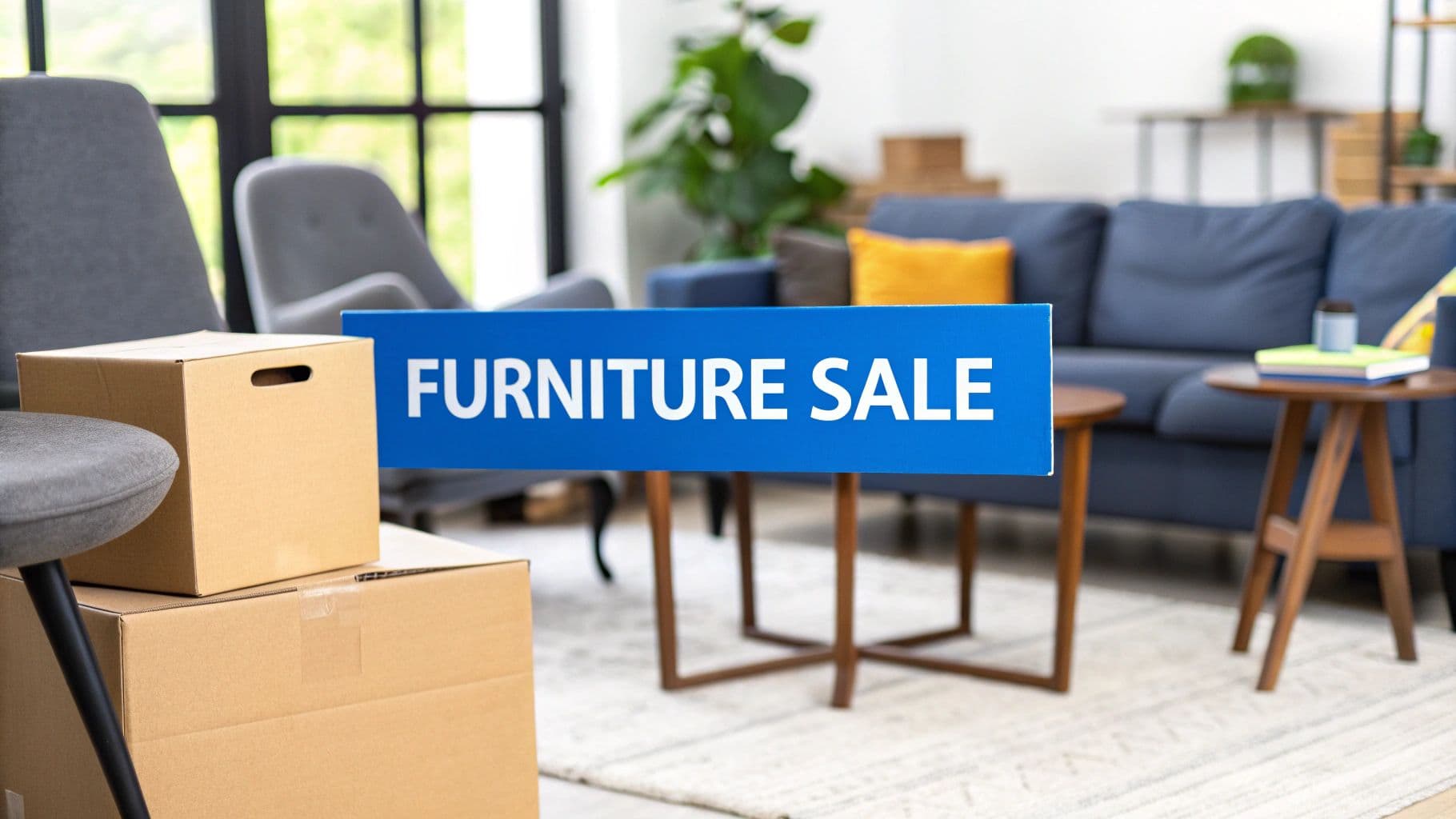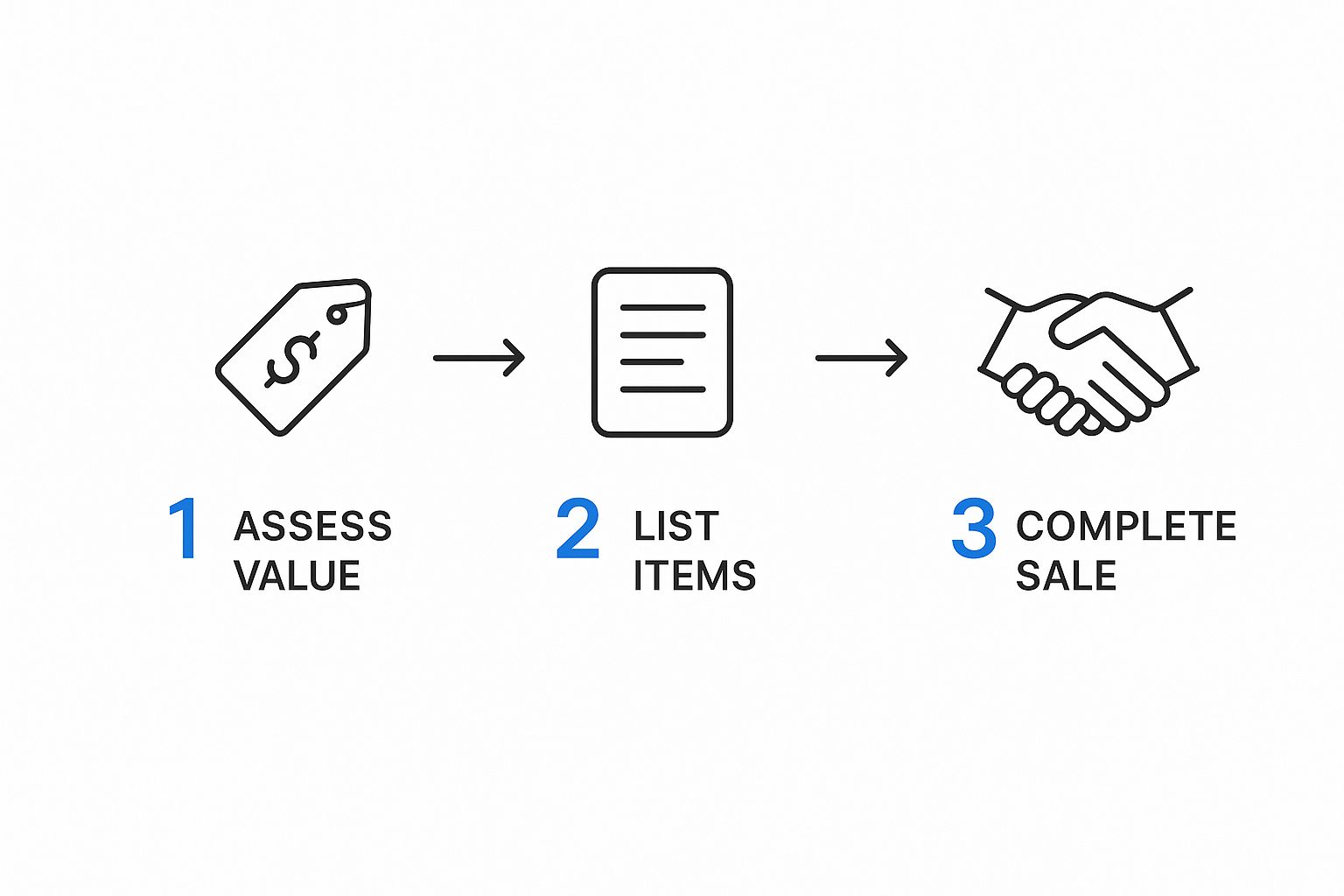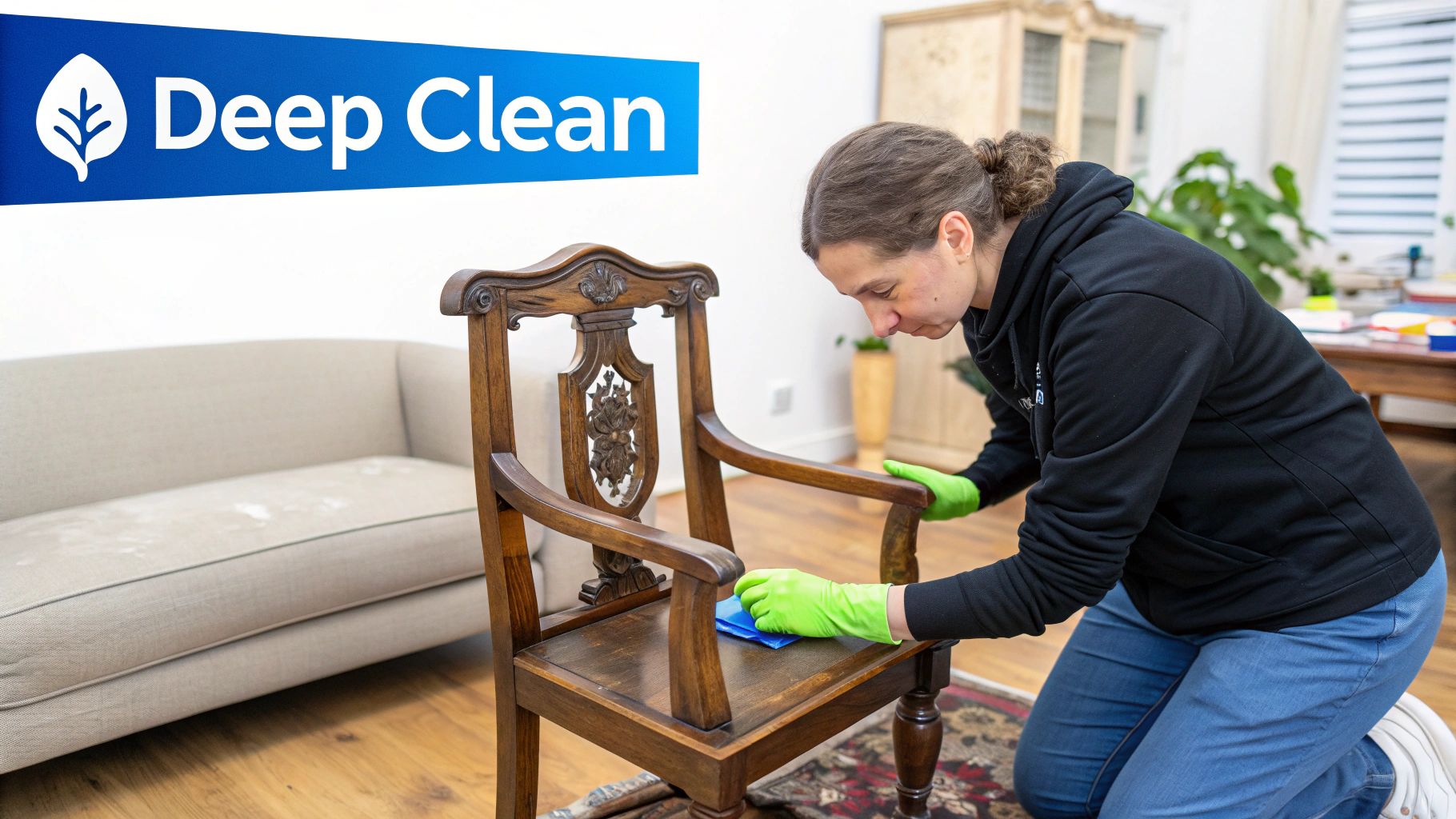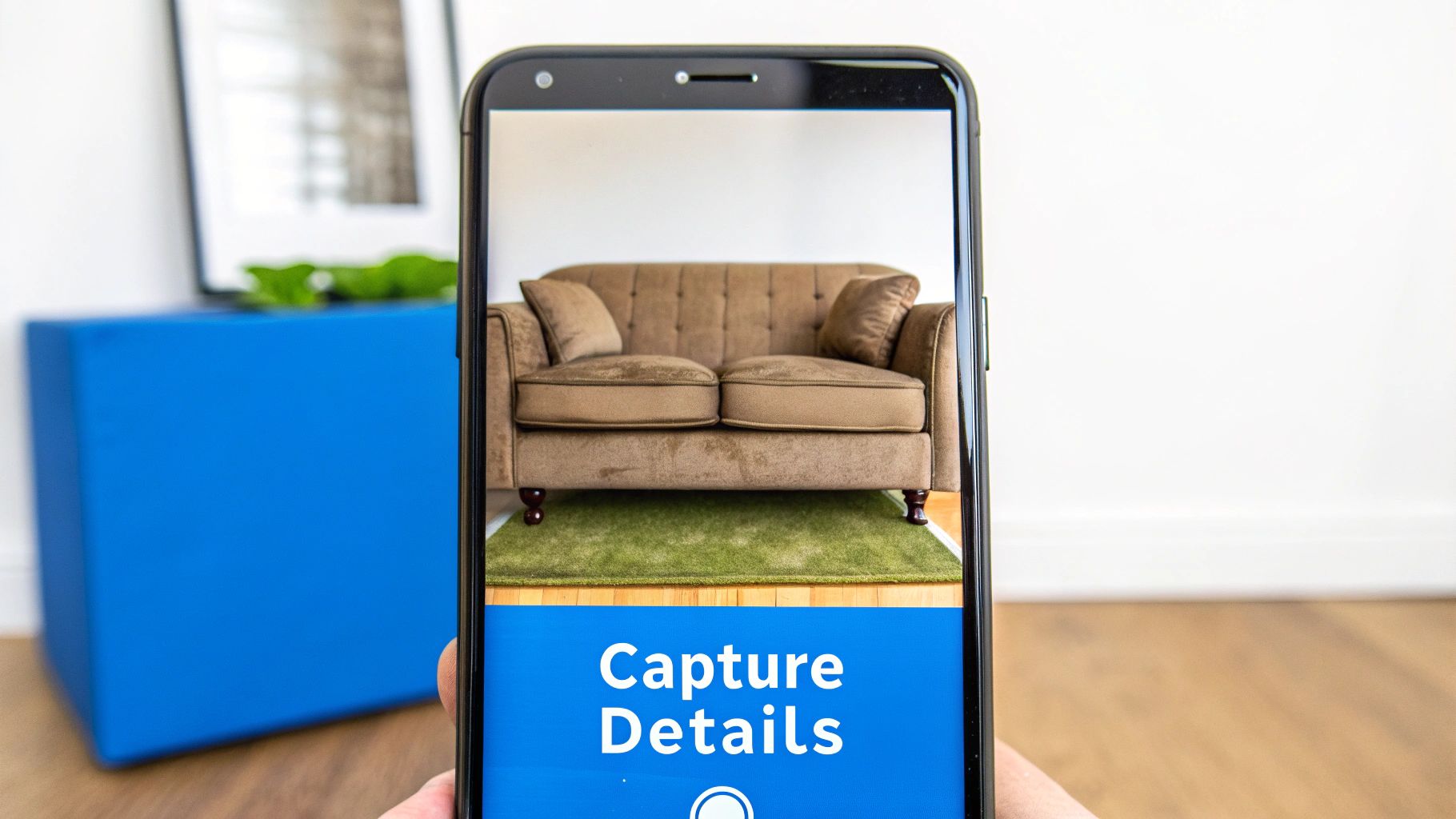How to Sell Furniture When Moving: Simple Tips for a Stress-Free Process

Trying to sell off furniture while you're also planning a move can feel like a recipe for chaos. But it doesn't have to be. The secret isn't some magic formula; it's just about having a straightforward plan: figure out what’s worth selling, take decent photos, write honest descriptions, and pick the right place to list it. Do that, and you can turn that extra clutter into cash long before the moving truck shows up.
Your Game Plan For A Profitable Furniture Sale
A move is the perfect excuse to finally deal with the furniture you've been meaning to get rid of. Instead of paying movers to haul pieces you don't even like anymore, you can sell them and use the money to fund your move or furnish your new place. It's less about luck and more about strategy. A successful sale really just comes down to understanding what buyers are looking for and showing them what you've got.
From my own experience, something as simple as a few well-lit photos and a clear description on a platform like Facebook Marketplace can bring in a flood of messages over a single weekend. Putting in that little bit of effort upfront makes the whole process smoother and helps you avoid the stress of last-minute lowball offers.
Create A Quick Inventory
Before you even think about taking pictures, grab a notepad or open a spreadsheet on your phone. Walk through your house and make a simple list of every single piece you plan on selling. This isn't just a to-do list; it's your first step in making a clear-headed decision about each item.
Beside each piece, jot down a quick note on its condition—"like new," "gently used," or "needs some TLC." This quick reality check helps you figure out which items to list first and gives you a good starting point for pricing. It's also the perfect time to identify items that might be better sold together in a larger lot. For anyone tackling a whole house's worth of items, it's worth checking out some estate sale tips to get a bigger-picture strategy.
Map Out Your Selling Process
Having a clear workflow is the key to not getting overwhelmed. The journey from a cluttered room to a pocket full of cash follows a simple, repeatable path.
This breakdown shows the basic steps you'll need to follow to sell your furniture successfully while moving.

As you can see, it’s a logical flow. You start by figuring out what you have and what it's worth, then move through the selling process until the final pickup. Following these steps ensures you don't miss anything important.
Set A Realistic Timeline
With a move-out date breathing down your neck, timing is everything. The biggest mistake people make is waiting until the last minute. When you're desperate, you're forced to take whatever lowball offer comes your way just to get the stuff out of your house.
Pro Tip: Start listing your furniture 4-6 weeks before you move. This gives you plenty of time to deal with offers, schedule pickups, and figure out a backup plan for anything that doesn't sell right away. For bigger, more expensive items, starting even earlier—maybe 8 weeks out—is an even better idea.
Prepping Your Furniture to Get Noticed
In the fast-paced world of secondhand sales, your furniture has just a few seconds to make an impression. Buyers scroll fast, and looks are everything. A little bit of prep work is often the only thing separating a quick, profitable sale from an item that gets completely ignored.
This is about more than just a quick wipe-down. Think about the small fixes that can seriously boost what a buyer is willing to pay. That wobbly chair leg you've been ignoring? A bit of wood glue and a clamp can fix it in an afternoon. Scratches on a coffee table can often be hidden with a simple furniture marker, instantly changing the description from "heavily used" to "gently loved."
These small efforts signal that you've actually cared for the piece, which is a huge green flag for a buyer who wants something they can use right away.
Mastering Your Listing Photos
Your photos have one job: to sell. Since buyers can't touch or inspect the furniture in person, your pictures have to do all the talking. You're aiming for bright, clear, and honest photos that show the piece exactly as it is.
- Let the Sun In: Morning light is perfect. It’s bright but soft, showing true colors without creating harsh, ugly shadows. Always try to position your furniture near a big window.
- Clear the Clutter: Nobody wants to see your gorgeous oak dining table buried under a stack of mail and your kid's latest art project. Create a clean, neutral background so the furniture is the absolute star of the show.
- Show Every Angle: Don't be shy. Take photos from the front, back, sides, and zoom in on any unique details like cool hardware or interesting wood grain. For things like dressers or nightstands, open the drawers to show they're clean and working properly.
A huge mistake I see people make is trying to hide the flaws. If there are dings or scratches, take a close-up photo and point them out. Honesty builds trust and saves you from a headache when the buyer shows up for pickup. They'll know exactly what they’re getting.
Staging and Writing for the Sale
Once your photos are ready, it's time to write a description that seals the deal. This is your chance to connect with a potential buyer and help them see why your item is the perfect one for their home.
I once sold a dated but solid bookshelf by staging it with a few modern hardcovers and a small succulent. That simple trick helped people visualize it in their own space, not just as some old thing I was getting rid of.
Your description needs to be clear and helpful. If it's a known brand, say so. Mention the materials ("solid oak," "walnut veneer") and always, always include the dimensions. This is also where you can lean into the massive demand for sustainable living. The global second-hand furniture market is now worth over $37 billion, and that's partly because over 70% of consumers are willing to pay more for eco-friendly products—and that includes pre-owned items.
By highlighting that your piece has been well-cared-for and is ready for its next life, you're tapping right into that mindset. You can discover more about the growth of the secondhand market and its powerful eco-friendly appeal.
Pricing Your Pieces for a Fast and Fair Sale

Let's talk about the trickiest part of selling furniture when you're moving: setting the price. It’s a delicate balance. Go too high, and your listing gets crickets while your moving date gets closer. Go too low, and you're leaving cash on the table—money that could easily cover your moving costs.
The goal is to find that sweet spot. You want buyers to feel like they’ve found a great deal, but you also need to feel fairly compensated for your item.
Your first step is some detective work. You need to see what similar items are actually selling for, not just what people are asking. Take a little time to browse the "sold" listings on platforms like OfferUp and Facebook Marketplace. This gives you a real-world benchmark for your area, because a dresser in Omaha will sell for a very different price than the same one in San Francisco.
Start with the 50-30-10 Rule
A good way to get a baseline price is by using what I call the "50-30-10 Rule." It’s a simple guideline that gives you a solid starting number before you start factoring in other details.
Here’s how it breaks down:
- 50% of Retail: For furniture that’s in like-new or perfect condition. Maybe it was tucked away in a guest room and saw almost no use.
- 30% of Retail: This is the sweet spot for most items. Think gently used pieces that have been well cared for but show minor signs of life.
- 10% of Retail: For items with noticeable wear and tear but are still completely functional. This could be a desk with some clear scratches on the surface or an armchair with faded fabric.
This rule is a great foundation, but it's not the final word. A solid wood dresser from a desirable brand like West Elm will always hold its value better than a particleboard piece from a big-box store. Brand, materials, and local demand all play a huge role.
Expert Insight: Remember, price is all about perception. When I sell vintage items, I often list them for 80-120% of what I originally paid because good design can actually appreciate in value. But for most modern furniture, aiming for 40-60% of the retail price is a much more realistic goal on platforms like Facebook Marketplace.
Price Strategically to Get More Clicks
A few small psychological tricks can make a huge difference in how many eyeballs your listing gets. It’s a classic retail strategy for a reason: pricing an item at $195 instead of $200 just feels like a much better deal, and it will get you more clicks.
You should also build a little wiggle room for negotiation into your price. Let’s be honest, almost everyone on a local marketplace expects to haggle.
By pricing your item about 10-15% higher than your absolute rock-bottom price, you create a cushion. This gives you the power to accept a lower offer, which makes the buyer feel like they scored a win, and you still get the amount you wanted all along.
For instance, if you know you need to get $150 for your coffee table, listing it for $175 is the smart play. When a buyer inevitably offers $150, you can accept it on the spot. This keeps the whole transaction friendly and fast—exactly what you need when you're on a tight moving schedule.
Choosing the Best Platforms to List and Sell

Where you list your furniture is just as critical as how you price it. Picking the right platform is the difference between a quick, easy sale and weeks of lowball offers and no-shows. Your best bet depends entirely on what you're selling, how fast it needs to go, and how much hands-on effort you're willing to invest.
When speed is your top priority, especially during a move, you can't beat the local-focused apps. For fast, no-shipping-required sales, platforms like Facebook Marketplace and OfferUp are your best friends. They're built for simplicity and getting items out the door. I once sold a bulky armchair in less than 24 hours on Marketplace just because the listing was clear and it was priced for a quick local pickup. These are perfect for standard, everyday furniture that needs a new home before the moving truck shows up.
Key Insight: The magic of local marketplaces is the massive, built-in audience. You’re tapping into a huge pool of people in your immediate area who are actively hunting for secondhand deals right now.
And this isn't a small trend. The global second-hand furniture market is set to expand significantly, all thanks to online platforms making it easier for budget-conscious and eco-friendly shoppers to find what they need. You can read the full research on the used furniture market to see just how big this opportunity has become.
Niche and High-End Platforms
If you're selling something special—designer, vintage, or a high-end brand name piece—don't throw it on a generic marketplace. Buyers there are usually looking for a bargain, not a B&B Italia sofa. You'll just get frustrated with lowball offers.
This is where specialized, curated platforms really shine:
- Chairish: This is the go-to for vintage, antique, and unique designer pieces. Buyers on Chairish expect quality and are absolutely willing to pay for it, but be aware they take a commission on the sale.
- AptDeco: A fantastic middle ground for contemporary and popular brand-name furniture (think West Elm or Crate & Barrel). They handle the payment and, more importantly, coordinate the pickup and delivery for you. That's a huge stress-reliever during a chaotic move.
It takes a bit more effort to create a standout listing on these sites, but the financial return can be much, much higher. They cater to a specific audience that appreciates quality and design over a rock-bottom price. For those with varied or valuable collections, it's also worth learning about the best place to sell collectibles, since the strategy for reaching a niche audience is very similar.
The Hands-Off Approach with Consignment
What if you have zero time to manage listings and meet with potential buyers? Local consignment shops are an excellent, low-effort alternative. I once had a beautiful but very old antique armchair that I knew needed a specific buyer. With my move date getting closer, I simply dropped it off at a trusted local consignment store.
They took care of everything—the staging, the sale, the payment—and I just came by to collect a check a few weeks later. Yes, you'll split the profit (typically a 40-60% split), but it's a completely zero-effort way to sell quality pieces. It’s the perfect answer for how to sell furniture when moving if your schedule is already overflowing.
Handling the Pickup and Payment Safely
Alright, let's talk about the final handoff. This is where all your hard work pays off, but it can also be the most stressful part of the deal. Getting the exchange right is all about clear communication and setting firm boundaries from the start. This is especially true when you're on a tight moving schedule and can't afford delays.
Before a buyer is even on their way, you need to lock in a firm pickup window. Don't leave it open-ended with a vague "sometime this weekend." That's a surefire way to have your entire day held hostage. Instead, offer specific blocks of time, like "Saturday between 10 AM and 12 PM." It shows you respect your own time and filters out flaky buyers.
Set Your Ground Rules for Pickup
To head off any last-minute drama, be completely clear about your pickup rules right in the listing itself. This sets expectations early.
My go-to line has always been: "Buyer must bring help and appropriate vehicle to move."
Seriously, put that sentence in every listing for a large item. It single-handedly prevents the painfully awkward situation where someone shows up alone in a tiny car, expecting you to somehow load a heavy dresser. You are not a free moving service.
For smaller pieces, the "porch pickup" method is a game-changer. It's a fantastic, no-contact way to handle a sale. Once you've received payment digitally, you can just leave the item in a safe, designated spot for them to grab. This works perfectly for things like end tables, lamps, or office chairs.
Managing Payments Securely
Getting paid safely is just as important as the pickup itself. Cash might feel simple, but it has its own headaches, including the risk of counterfeit bills. In most cases, digital payment apps are a much better and safer way to go.
One of the most common scams on marketplaces involves a buyer using a payment method with strong buyer protection (like PayPal Goods & Services). They pick up the item, then file a fraudulent claim saying they never got it. Suddenly, you're out both the furniture and the money. Stick to apps designed for immediate, in-person transfers to protect yourself.
Here’s a quick rundown of the best payment options:
- Zelle: This is a top-tier choice. Once the money hits your account, the transaction is final. The sender has no way to reverse it.
- Venmo: Generally safe, but be sure to tell the buyer not to mark the transaction as a "purchase." If they toggle that protection on, they can file a dispute later on.
- Cash: If you must accept cash, check the bills carefully. For any large amount, it's smart to arrange the meeting at your bank, where they can verify the bills on the spot.
If you're managing a much larger sale, like a full home liquidation, things can get more complicated. It can be helpful to see how the pros handle it. Taking a moment to read up on understanding estate sale commissions will give you a ton of insight into how large-scale transactions are managed, giving you more confidence to handle your own sales.
What to Do If Your Furniture Doesn't Sell

It’s a familiar feeling: the moving date is creeping closer, and that one bulky armchair is still sitting there, unsold. Don't panic. The key to a stress-free move is having a solid plan B for those stubborn pieces.
When you notice an item isn't getting any bites, it’s time to sweeten the deal. Try bundling a desk and chair into a single package or launching a “Moving Sale: Everything Must Go!” post with some serious discounts. Sometimes, that's all it takes to spark fresh interest.
Smart Last-Ditch Sale Tactics
Creating a sense of urgency is your best friend here. Adding a simple "3 Days Left!" to your listing can nudge hesitant buyers into action. I also watch my listings closely and adjust prices in small increments based on how much (or how little) attention they’re getting. It keeps you competitive without giving things away too early.
Limited-time bundles signal no-nonsense deals to buyers needing furniture fast.
A few tactics I’ve used successfully:
- Bundle matching items, like a desk and chair or a pair of nightstands with their lamps.
- Apply incremental discounts. If an item hasn't sold in 48 hours, knock 15% off.
- Highlight same-day or next-day pickup for buyers in a rush.
Donation and Free Options
If a piece still hasn't sold and your deadline is here, it’s time to pivot to your donation or free pickup plan. No exceptions.
I always set a hard "sell-by" date for every single item. The moment that day passes, I immediately switch gears and start arranging its donation. It’s a simple rule that keeps the process moving.
Donating accelerates clearance and benefits local charities while clearing space.
When selling isn’t an option anymore, here’s what to do:
- Schedule a pickup with an organization like Habitat for Humanity ReStore.
- Post your items on local Buy Nothing groups on Facebook.
- Use neighborhood apps for a "curb alert" to have someone haul it away for free.
- For broken items, look into recycling or scrapping any metal frames.
Interestingly, shifting global trade dynamics can sometimes make well-priced secondhand furniture even more appealing to local buyers. You can learn more about these trade impacts and how they might affect the market.
Local Swap And Consignment
For those higher-value items that just didn't find the right buyer in time, consignment shops can be a lifesaver. They offer a way to sell stubborn pieces with almost zero hassle on your end.
I once dropped off an antique armchair at a trusted local shop just before my move. I didn't have to deal with another buyer, and two weeks later, a check arrived in the mail. Easy.
Consignment turns hard-to-move furniture into cash without you managing pickups.
Here's how to make consignment work for you:
- Research consignment stores with solid local reviews well in advance.
- Drop off your items before your personal sell-by cutoff date.
- Make sure you attach clear price tags or follow their intake process.
When consignment stores are full, check out neighbor swap networks like Freecycle or other local furniture exchanges. These platforms are fantastic for last-minute clear-outs, as buyers are often ready to pick up items the very same day.
By combining stepped discounts, a donation plan, and consignment options, you can guarantee you’ll clear out every single piece before the moving truck arrives. Just remember to set those deadlines for each item and track everything. A simple calendar note or spreadsheet will keep things from slipping through the cracks.
Common Questions About Selling Furniture
Even with a perfect game plan, a few questions always seem to pop up once you actually start selling your furniture before a move. Let’s tackle some of the most common ones I hear from sellers so you can move forward with confidence.
Should I Sell Pieces as a Set or Individually?
This is a classic dilemma. When you have a high-quality, truly matching set—like a dining table with its original chairs or a complete bedroom suite—you’ll almost always get a better price by selling it together. Buyers love the convenience of a ready-made, cohesive look and are often willing to pay a premium for it.
On the other hand, if your pieces are more of a mix-and-match collection or you’re in a hurry, listing them individually is the smarter move. It opens you up to a much wider pool of buyers who might only need a single nightstand, a specific dresser, or a standalone desk.
My Two Cents: Always try listing a genuine set together first. If you don't get any serious bites after a week or so, don't hesitate to break it up and create separate listings for each piece.
When Is the Best Time to Start Selling Before a Move?
Timing is absolutely critical. You want to hit that sweet spot between having enough time and creating a sense of urgency.
I’ve found the magic window is 4-6 weeks before your move date. This gives you a comfortable buffer to take photos, write good listings, and chat with potential buyers without the stress of a looming deadline breathing down your neck. For big-ticket items like a large sectional or a valuable antique, you might even want to start 8 weeks out.
How Should I Handle Price Negotiations?
Let's be real: most people browsing local marketplaces expect to haggle. It's part of the game. The best way to prepare is to price your items about 10-15% higher than the absolute lowest price you'll accept. This builds that negotiating room right into your listing.
When a lowball offer comes in, stay polite but firm. I’ve had great success with a simple reply like, "My price is fairly firm, but I can do X for a quick and easy pickup." This shows you're a little flexible but also signals that you know what your item is worth.
Can I Sell Furniture That's Damaged?
You absolutely can, but the golden rule is 100% transparency. Honesty is the only way to go.
Make sure you take crystal-clear, close-up photos of every single scratch, stain, dent, or functional issue. Describe the flaws directly and honestly in your listing—don't try to hide them. Then, price the item fairly to reflect its condition. This simple step prevents frustrating arguments or last-minute renegotiations when the buyer shows up for pickup.